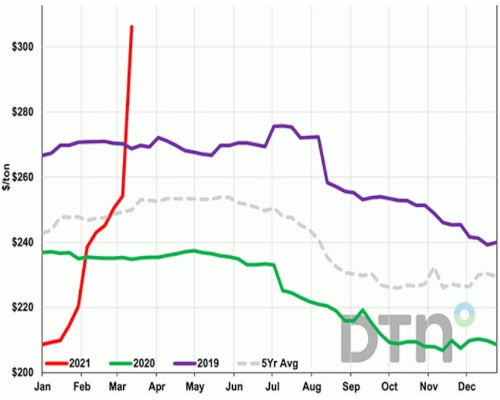The recent surge in fertilizer prices has caught farmers’ attention if recent inquiries from farmers and reports by Nebraska Farm Bureau board members are any indication. Fertilizer prices across the board have moved markedly higher since the beginning of the year. According to DTN, anhydrous ammonia prices are up 19 percent over the past month, urea ammonium nitrate (UAN) prices are up 21-26 percent depending on the formulation (Figure 1), urea prices are up 7 percent, and potash is up 6 percent. In fact, DTN reports the UAN28 price is above the $300/ton level for the first time since September 2015. Fertilizer costs account for roughly 15 percent of total cash farm costs in the U.S., so higher prices are bound to get farmers’ attention.
Figure 1. Average Weekly Price for UAN28

Weather, tariffs, and corn prices are all contributing to the higher prices. Most fertilizer production occurs in Louisiana, Oklahoma, and Texas near plentiful stocks of natural gas, a key component in fertilizer production. Severe cold weather in mid-February forced the shutdown of many production facilities in these states due to power outages and loss of gas supplies. In addition, with the spike in natural gas prices caused by the cold weather, some fertilizer producers found it more profitable to sell natural gas stocks rather than produce fertilizer. These supply hiccups only exacerbated an already tight supply situation pushing prices higher.
Tariffs on imported phosphate are also contributing to higher prices. Earlier this month, the U.S. International Trade Commission voted to impose countervailing duties on phosphate imports from Russia and Morocco. According to the American Farm Bureau Federation, imports from these two countries combined account for 75 percent of U.S. phosphate imports. The tariffs range from 9-47 percent depending on the supplier. The ruling came in response to a petition filed by Mosaic arguing Russia and Morocco were unfairly subsidizing fertilizer production through loans, tax breaks, and other means. National Corn Growers, American Soybean Association, and National Cotton Council said the tariffs could decrease farmer income by $800 million. The tariffs come on top of tariffs already imposed on phosphate imports from China by the Trump administration.
Finally, higher corn prices have increased the demand for fertilizers. More corn acres are expected to be planted in 2021 relative to 2020. In a recent non-scientific poll of Nebraska Farm Bureau members participating on a webinar, 60 percent indicated they intended to plant more corn acres. Nationwide, the USDA forecasts corn acres will increase by 1 million. The increase in corn acres means greater fertilizer demand also contributing to rising fertilizer prices.
Click here to see more...